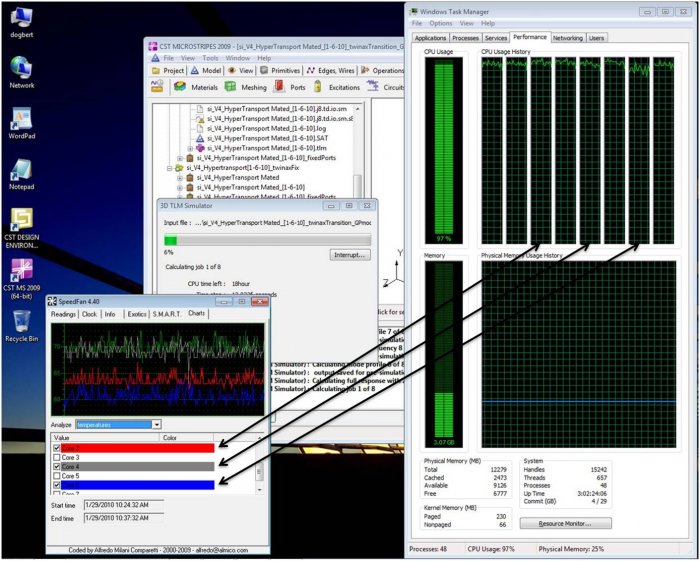Psi*
Tech Monkey
This isn't really a complaint, whine, or kudos about Win 7. I guess it is an observation & maybe a bit of a stretch at that. The pic below shows 8 threads of one of my favorite programs running running ... and it 'tis a beautiful thing!
 Also shown is SpeedFan & Core 0, 2, 4, 6 temps.
Also shown is SpeedFan & Core 0, 2, 4, 6 temps.
You will notice a couple of things. Most obvious per SpeedFan, there is quite a difference across the core temps. It has always been this way & stock clock or OC-ed (this pic is at 4.4+ GHz ) loaded or at idle. And, was also this way before putting the Indigo Xtreme in ... I did have Arctic Céramique thermal paste that came with the water block for system setup.
) loaded or at idle. And, was also this way before putting the Indigo Xtreme in ... I did have Arctic Céramique thermal paste that came with the water block for system setup.
Also, you can tell that there really is *not* a 1:1 correspondence between core temps & CPU load. Well, maybe. But it is not consistent. The order of the core temps is always the same and very similar to this spread.
Also note that the load is not completely balanced across all threads. Thread #6 is a few percent lower. Probably splittings hairs. Except that sometime the lower thread is #2 & #6 is level-ish with the rest.
Don't you wonder why the threads vary only & not the pair of threads on a core?
I have not turned off hyperthreading in bios just to see how things might balance out. Although typically this program has always maxed (99% to 100%) the CPU load at 4 threads on previous CPUs. The program does complete much more quickly with 8 threads tho. So there is not a lot of incentive to do that.
This does get me thinking about the burn in programs. They do a great job of maxing the CPU load ... 100%. Perhaps an interesting option would be a means of dialing down the CPU utilization by percent, not with thread count?
You will notice a couple of things. Most obvious per SpeedFan, there is quite a difference across the core temps. It has always been this way & stock clock or OC-ed (this pic is at 4.4+ GHz
Also, you can tell that there really is *not* a 1:1 correspondence between core temps & CPU load. Well, maybe. But it is not consistent. The order of the core temps is always the same and very similar to this spread.
Also note that the load is not completely balanced across all threads. Thread #6 is a few percent lower. Probably splittings hairs. Except that sometime the lower thread is #2 & #6 is level-ish with the rest.
Don't you wonder why the threads vary only & not the pair of threads on a core?
I have not turned off hyperthreading in bios just to see how things might balance out. Although typically this program has always maxed (99% to 100%) the CPU load at 4 threads on previous CPUs. The program does complete much more quickly with 8 threads tho. So there is not a lot of incentive to do that.
This does get me thinking about the burn in programs. They do a great job of maxing the CPU load ... 100%. Perhaps an interesting option would be a means of dialing down the CPU utilization by percent, not with thread count?

